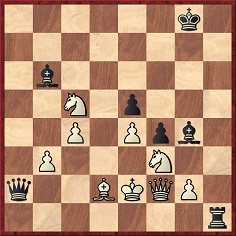
Edward Winter
Games are sought which exemplify the various tactical and strategical devices. The less well-known the better. We begin with the pin and would welcome cases where one player is totally tied up by this means. An example is the fabulous game Kovačević v Seirawan, Wijk aan Zee, 1980. An old favourite of ours, almost never reprinted by writers is the following:
Hans Fahrni – Boris Maliutin
Triberg tournament, 4 May 1916
Ruy López
(Notes are abbreviated from Maliutin’s own.)
1 e4 e5 2 Nf3 Nc6 3 Bb5 Nf6 4 d3 d6 5 h3 Be7 6 Nc3 O-O 7 Be3 Bd7 8 O-O a6 9 Ba4 b5 10 Bb3 Na5 11 Ne2 c5 12 c3 Qc7 13 Bg5 (‘13 Bc2 d5.’) 13...Nxb3 14 axb3 Be6 15 c4 (‘A strategic error.’) 15...h6 16 Bd2 Kh7 17 Ng3 Qd7 18 Kh2 Ng8 (‘I came to the conclusion that the way to push the pawns was ...g6, followed by ...f5 and ...f4.’) 19 Ne1 g5 (‘White’s rejoinder provokes an alteration in Black’s plan. It is now necessary to prevent White from playing f4.’) 20 f3 Rfb8 (‘20...f5 would have been advisable without delay.’) 21 Ra2 Bf8 22 Nc2 f5 23 Qa1 (‘An unaccountable error. 23 exf5 Bxf5 24 Nxf5 Qxf5 ought to have been played.’) 23...f4 24 Nh1 Nf6 25 Bc3 Qb7 26 Qd1 Be7 27 Qe2 Rg8 28 Nf2 h5 29 Rh1 Rg6 (‘If I had taken into consideration White’s reply, I should have played ...b4 and then proceeded calmly with the offensive on the king’s side.’) 30 b4 a5 31 Rxa5 Rxa5 32 bxa5 b4 33 Bd2 Bd8 34 d4 Bxa5 35 dxe5 dxe5 36 b3 g4 37 hxg4 hxg4 38 Kg1+ Kg8 39 Ne1 Qg7 40 Nfd3 Rg5 41 Kf1 Nh5 42 Rxh5 Rxh5 43 Qf2 Rh1+ 44 Ke2 Bb6 45 fxg4 Bxg4+ 46 Nf3 Qh7 47 Nxc5 Qa7 48 Bxb4 Qa2+ 49 Bd2

49...Qc2 50 White resigns. (‘A curious position. White’s pieces are as good as stalemated, the few moves possible resulting in mates.’)
Source: The ‘British Chess Magazine’ Chess Annual, 1916, pages 120-121.
(349)
Sub-standard definitions of the term ‘pin’ are to be found in many chess books. For instance, the glossary on page 180 of Chess The Easy Way by Reuben Fine (Philadelphia, 1942) offered a one-sentence explanation:
‘A pin occurs when a man screens a unit of higher value.’
From page 200 of The Everything Chess Basics Book ‘by the US Chess Federation and Peter Kurzdorfer’ (Avon, 2003) comes a description which is also everything but helpful:
‘Pin. This is a weapon that requires two enemy pieces on the same line with a friendly long-range piece. Instead of two good guys and one bad guy on the line, as in a discovered attack, we have one good guy holding two bad guys hostage. Well, only one of them is actually held hostage, but they both have to be there.
The pin is more akin to a wrestling pin than to a sewing pin. In it, one friendly long-range piece looks at a powerful enemy piece with a less powerful enemy piece shielding it.’
Reference books shun the question of when ‘pin’ became part of chess terminology. On page xii of his Introduction to Chess Studies (London, 1844) George Walker wrote:
‘Of course I consider that all players for whom I have made up these Chess Studies are acquainted with the ordinary chess terms, as bishop “pins” knight, and similar conventional phrases.’
How much further back can ‘pin’ be traced in chess literature?
(3298)
In Earliest Occurrences of Chess Terms we give:
‘If he move Q. to K. fourth, you answer with Q.B. to B. fourth, and then pin Kt., if he return with Q. to Q.B. sixth.’ A New Treatise on Chess by G. Walker (London, 1833), page 88.
‘In chess the “pin” is mightier than the sword!’
So wrote Robert M. Snyder on page 75 of Chess for Juniors (New York, 1991), but a more careful author would have refrained from using Fred Reinfeld’s old quip without attribution. Reinfeld quoted his remark on page 293 of The Treasury of Chess Lore (New York, 1951), but we do not know when he first came up with it.
(3599)
No reader has yet pointed out any pre-1951 instances of Reinfeld writing his quip ‘The pin is mightier than the sword’. We can, though, add that on page 159 of his book Great Moments in Chess (New York, 1963) he offered a simple variant: ‘... the pen is mightier than the pin’.
(3625)
C.N. 3599 commented, ‘Reinfeld quoted his remark on page 293 of The Treasury of Chess Lore (New York, 1951), but we do not know when he first came up with it’. That remains the case, but page 32 of the March 2006 CHESS points out that it was also attributed to Reinfeld when quoted under the chapter heading on page 7 of an earlier work, Winning Chess (co-authored with Irving Chernev). That book was first published in 1948 (not 1949 as stated by CHESS), and the quest continues for any previous appearance of the phrase in Reinfeld’s output.
(4313)
As reported in C.N. 4313, Fred Reinfeld’s remark ‘the pin is mightier than the sword’ was ascribed to him under the chapter heading on page 7 of Winning Chess (New York, 1948), a work which he co-authored with Irving Chernev.
The book was published in or around May 1948 (see page 3 of the 20 May 1948 Chess Life), and a slightly earlier occurrence of the quip can now be offered:
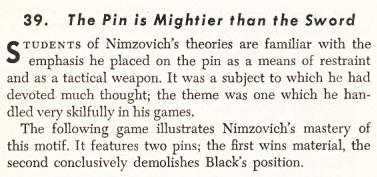
Source: page 147 of Reinfeld’s Nimzovich the Hypermodern (Philadelphia, 1948). The book was reviewed on page 2 of the 5 March 1948 issue of Chess Life.
(7799)
The saying ‘The pin is mightier than the sword’ (which has been traced back to Fred Reinfeld in 1948 – see C.N. 7799) has occasionally been attributed to Al Horowitz. For instance, on page 45 of the January 1975 Chess Life & Review Walter Meiden and Norman Cotter wrote:
‘The late Al Horowitz, who was publisher of Chess Review, used to say: “The pin is mightier than the sword”.’
And from page 79 of The Art of Positional Play by Samuel Reshevsky (New York, 1976):
‘The late I.A. Horowitz used to quip: “The pin is mightier than the sword”.’
Loose claims about what people ‘used to’ say/quip obviously lack credibility, and Horowitz himself attributed the phrase to Reinfeld:
‘... there are pins and pins, despite Reinfeld’s dictum that “the pin is mightier than the sword”.’
Source: page 70 of Chess for Beginners by I.A. Horowitz (New York, 1950).
(8730)
Irving Chernev attributed this quip to Alvin C. Cass; see an inside front-cover page of the January 1950 Chess Review, concerning the game Soyka v Kolta, Vienna, 1924:
1 e4 e5 2 g3 g6 3 Bg2 Bg7 4 Ne2 Ne7 5 d3 Nbc6 6 O-O O-O 7 f4 exf4 8 Bxf4 Bxb2 9 Nd2 Bxa1 10 Qxa1 f6 11 Bh6 Rf7 12 Rxf6 Qe8 13 Nf3 Rxf6 14 Qxf6 Qf7 15 Qc3 d5 16 Ng5 d4 17 Nxd4 Qf6
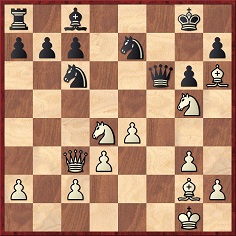
18 Nxc6 Resigns.
The game is in Tartakower’s Die hypermoderne Schachpartie:

The following is the entry in the Oxford English Dictionary for the term half-pin:
‘1922 HUME & WHITE Good Companion Two-Mover 245 The term “half-pin” arose in 1915, in correspondence between Comins Mansfield and Murray Marble anent No. 122 D, a surprising example, with six half-pins ... Greenwood, the composer of this problem, had published a complete half-pinner in 1859. 1926 H. WEENINK Chess Problem 71 By a Half-pin is understood an arrangement where two Black pieces stand in line in such a way that if either one moves the other becomes pinned by a White piece which has been standing behind both of them waiting to exert its pinning powers. 1928 Observer 24 June 25 These three variations are highly complex, the first two illustrating the unpin of the White Q by half-pinned Black Kt’s; the third is a half-pin line combined with Black interference.’
Michael McDowell (Westcliff-on-sea, England) provides further details:
‘Comins Mansfield published the following problem in the Hampshire Telegraph and Post, 19 November 1915:
Mate in two
It won first prize in the newspaper’s July-December 1915 competition, and when the solution was given on 10 December 1915 the column’s editor, G.W. Chandler, wrote:
“No. 422, by C. Mansfield, is a highly original work, containing a number of strategic and complex variations. The ‘half-pinned’ black pieces, to use a term suggested by the author, put up a lively defence, and the manner in which they pin each other and obstruct other B pieces is extraordinary.”
A.C. White mentions the origin of the term twice in the Christmas books, and contradicts himself. From page 245 of The Good Companion Two-Mover by G. Hume and A.C. White (Stroud, 1922):
“The term ‘half-pin’ arose in 1915, in correspondence between Comins Mansfield and Murray Marble anent No. 122D [i.e. the above problem], a surprising example, with six half-pins, which first drew the general attention of students to the theme. The term was perhaps first used in print in the criticism of No. 123B (G.C. 808), in the folder for March 1916.” [Does he mean “half-pin” as opposed to “half-pinned”, or is this just a lapse of memory? I am sure A.C. White would have received the Hampshire Telegraph and Post column.]
However, from page 8 of A Genius of the Two-Mover. A selection of problems by Comins Mansfield by A.C. White (Stroud, 1936):
“Indeed it was he who coined the expressive term, half-pin, in correspondence with G.W. Chandler.”’
A further question is when the term half-pin first appeared in connection with over-the-board play. In C.N. 545 our correspondent mentioned that Alekhine’s annotations to the game between Botvinnik and Vidmar in the Nottingham, 1936 tournament book contained the following remark in the note to 11...Bd7 (page 234):
‘The half-pinning of his KKt, which seems so harmless at the moment, will in a few moves become extremely disagreeable for Black.’
We add that a notable occurrence of the term was on page 161 of The Unknown Capablanca by David Hooper and Dale Brandreth (London, 1975). In a simultaneous game between the Cuban and Erling Tholfsen in Brooklyn on 7 March 1924 (and not 1923 as stated in the book) the following position arose:
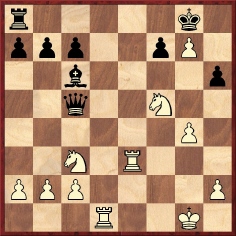
In reply to 26...Qc5 Capablanca played 27 Rd4, and the co-authors commented:
‘One of the most beautiful moves ever seen in a game of chess. White half-pins his rooks so that either is free.’
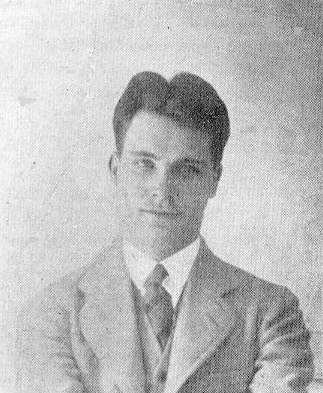
Erling Tholfsen
(4361)
Wanted: information about a position on pages 19-20 of book one of Test Your Chess IQ by A. Livshitz (Oxford, 1981):
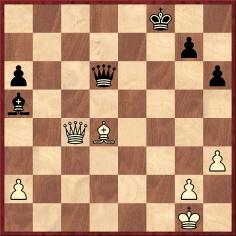
The conclusion was given as 1 Bc5 Bb6 2 Qf4+ Resigns, the game being identified as ‘Brundtrup [sic – Brüntrup] v Budrich, Berlin, 1954’.
(8719)
We wonder whether Irving Chernev was the first writer to use the term ‘counter-counter-pin’, on page 63 of Combinations The Heart of Chess (New York, 1960). He was discussing a variation in the game Boleslavsky v Bisguier, Helsinki Olympiad, 1952:
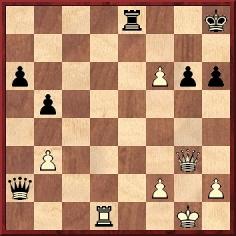
‘White moved 1 Q-B7 and eventually won. Had he played 1 QxP instead, to allow a pin and then break it with a counter-pin, he would have been trapped by a counter-counter-pin.’
The line in question, 34 Qxg6 Rg8 35 Rd8 Qb1+, had been given by Boleslavsky on page 188 of his book Izbrannyye partii (Moscow, 1957); see also page 164 of the English edition, Selected Games edited and translated by Jimmy Adams (London, 1988). Boleslavsky furthermore suggested that 34 f7, rather than 34 Qc7, would have won more quickly, but readers armed with a strong computer program will make interesting discoveries.
(6161)
From Michael McDowell (Westcliff-on-sea, England):
‘Chernev’s term strikes me as ill-conceived, as counter-counter-pin implies three pins altogether. I was reminded of the following study (by A. Troitzky and V. Korolkov; second Honourable Mention, Shakhmaty v SSSR, 1938) quoted on page 91 of Harold Lommer’s book 1357 End-Game Studies (London, 1975):
White to move and win
1 Rb4 Rh4 2 c4 Rxc4 3 Bb5 Bd7 4 Rd8 wins.
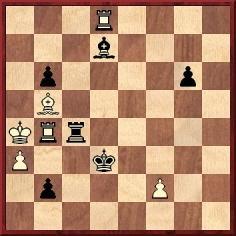
If 4…b1(Q) 5 Rxd7+ Ke4 6 Bxc4.
Harold van der Heijden’s database gives 1…Kxc3 as a refutation, and an alternative version with the black rook on h3 rather than h5. Is this latter setting sound? The study is not included in the 1958 and 1998 collections of Korolkov’s work.
The study below (by André Chéron, published in the Journal de Genève, 23 February 1974 and dedicated to Harold Lommer) is given on page 152 of Chéron’s book Le joueur d’échecs au pays des merveilles. The van der Heijden database has the f8 rook on a8. Is the database position Chéron’s original setting and the 1982 setting an amendment as a result of unsoundness? Is either setting sound?
White to move and win
1 Rb4 Rg4 2 c4 Rxc4 3 Bb5 Bd7 4 Rd8 b1(Q) 5 Rxd7+ Ke4 6 Bxc4 Qa1 or …Qc1
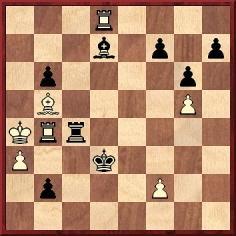
7 Bd3+ Kf3 8 Rxf7+ Kg2 9 Rg4+ Kh3 10 Rg3+ and 11 Rxh7 mate.’
(6183)
From Harold van der Heijden (Deventer, the Netherlands):
‘The Chéron study as in my database (with a white rook on a8) is the original setting published in the Journal de Genève of 23 February 1974, page 20. My own source was EG issue 37 (September 1974, page 128) with essentially the same story.
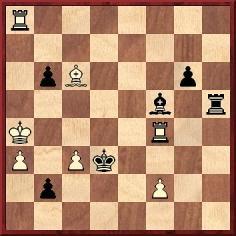
Key move: 1 Rb4
The original setting of the Troitzky/Korolkov study was cooked by 1...Kxc3 by K. Benson on page 557 of the October 1994 BCM. The correction (Black’s rook on h3 instead of h5) was proposed by me in the June 2004 issue of EBUR, page 11. Now 1...Kxc3 is elegantly refuted by 2 Rb3+ Kc2 3 Be4+ Bxe4 4 Rc8+ (with a black rook on h5 Black can play ...Rc5 here) 4...Kd1 5 Rxb2 with a technical win. After 1 Rb4 Rh4 2 c4 Kc3 3 Kb5 b1(Q) 4 Rxb1 Bxb1 5 Bd5 Black seems unable to stop Kxb6 and the quick advance of the white a-pawn.’
(6195)
From page 58 of Blunders and Brilliancies by Ian Mullen and Moe Moss (Oxford, 1990):
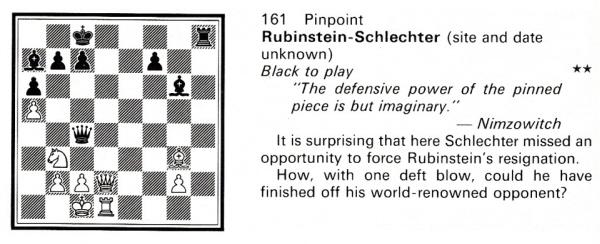
The co-authors did not state their source for the position. Such a finish (with the move ...Be3 overlooked) did occur in a game (Berlin, 1918) between the players named, but Schlechter was White. The position, moreover, was slightly different:
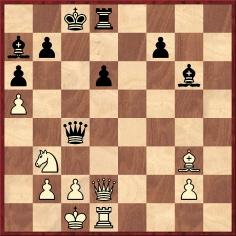
The game was annotated by Emanuel Lasker (who mentioned the players’ extreme time-trouble at move 30) on pages 14-15 of Das Großmeister-Turnier im Kerkau-Palast zu Berlin im Oktober 1918:
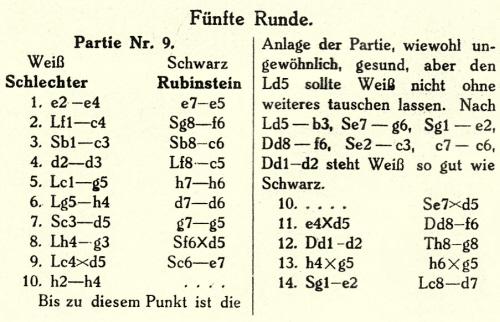
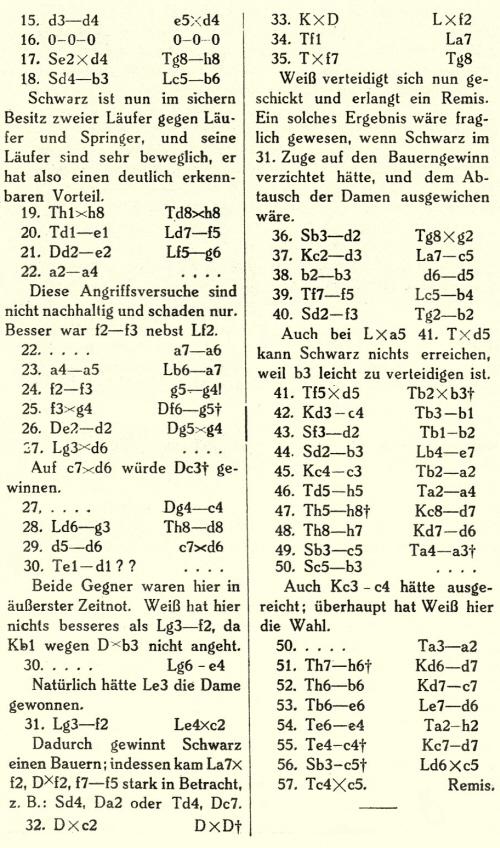
See too page 321 of volume one of The Life & Games of Akiva Rubinstein by John Donaldson and Nikolay Minev (Milford, 2006).
(8715)
Concerning the Nimzowitsch quote given by Mullen and Moss (C.N. 8715), the following appeared in the chapter on pins in My System, e.g. on pages 96-97 of the original English-language edition (London, 1929):
‘A pinned piece’s defensive power is only imaginary. He only makes a gesture as if he would defend; in reality he is crippled and immobile. Hence we may confidently place our piece en prise to a pinned piece, for he dare not lay hands on it.’
From page 133 of Nimzowitsch’s original text, Mein System (Berlin, 1925):
‘Ein gefesselter Stein deckt nur imaginär. Er tut nur so, als ob er decken würde; in Wirklichkeit ist er ja gelähmt und unbeweglich. Daher darf man seine eigenen Offiziere getrost en prise stellen; der gefesselte Stein darf doch nicht zugreifen.’
A different wording in English, ‘The defensive power of a pinned piece is only imaginary’, was given as a Nimzowitsch quote on page 7 of Winning Chess by Irving Chernev and Fred Reinfeld (New York, 1948). On page 61 of A First Book of Morphy (Victoria, 2004) Frisco Del Rosario attributed the remark ‘The defensive power of a pinned piece is illusory’ to Reinfeld.
(8716)
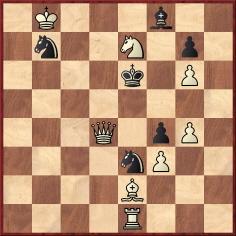
Mate in two
The solution is 1 Kc7, and if 1...Nd5+ 2 Bc4 mate. This problem, by J. Paul Taylor, was given in the ‘Puzzles’ section of his book Chess Chips (London, 1878). The solution at the end of the work (another unnumbered page) was ‘Kt to B7’, a typographical error pointed out by W.N. Potter on page 165 of the March 1879 Huddersfield College Magazine. On page 163 Potter described the composition as ...
‘... a two mover of Mr Taylor’s upon the Stevens’s principle, and it is no doubt an apt illustration of that most eccentric and unreasonable of deviations from the beaten track of chess’.
The problem as it appeared in Chess Chips:
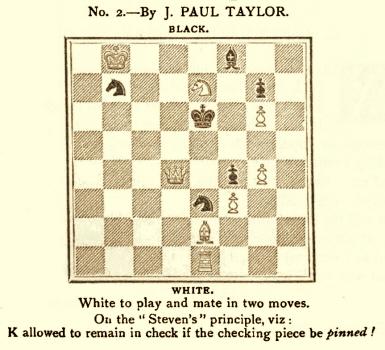
The ‘principle’ was advocated in a letter, ‘Metamorphose. A Novelty in Chess’, which S.J. Stevens of the City of London Chess Club contributed on pages 121-122 of the 1 November 1875 issue of the Westminster Papers. It was illustrated by this position:
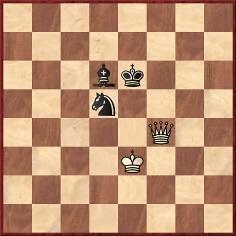
Stevens commented:
‘The king is now in check and, by the old code, must move, but by the new rule, as suggested, White can cover by queen to QB4, because the knight could not capture without discovering check upon his own king. If following this move B checks at B4, queen cannot capture, as it would leave the king in check. If B checks at B5, the queen cannot capture for the same reason, but the king can then take, as his condition is relatively the same; and lastly, if Black, instead of moving his B on the second move, play K to any square but B2, the conditions are altered, the white king is really in check, and the king must move or the knight be taken.’
The letter from Stevens gave a lengthy explanation of his proposal (‘an antidote ... to the universal bane of bookishness’). A further extract:
‘For reasons, perhaps only too obvious, there is, on the part of players possessing, in a large degree, the faculty of originality combined with ingenuity, a disrelish to compete with players who have digested, if not swallowed, the standard tomes of the great masters, and satiated their minds with the masterpieces of every finished executant from Philidor to Morphy. Undoubtedly most, if not all, of the many attempts to afford a more extended scope for original variety have been set on foot with a desire to counteract what is regarded as the worst features of the cramming system. A mental joust at chess should be each combatant deploying his own forces, unaided by supplementary assistance.’
Only the problem world seems to have taken any interest in the Stevens ‘principle’, although it was not widely known. Below is an item on pages 208-209 of the April 1913 Chess Amateur, in H. Meek’s ‘Half-Hours’ column:
‘The Powerless Pinned Piece
Many suggestions appear from time to time, spring-time not excepted, for varying the “game and playe of the chesse”. Problem composers, especially, are grumbling because they have, seemingly, exhausted all orthodox methods of construction. We do not think the following suggestion has ever before been made: When a piece or pawn is “pinned” to its king, the said piece or pawn shall be entirely powerless. The chief innovation would be to allow the opposing king to move to squares which, under present rules, are “governed” by the “pinned” man. The sudden release of a “pinned” piece when the opposing king stands on a “governed” square should introduce novel and exciting complications. Would any composer care to send up an illustrative problem?’
This prompted a feature, with Stevens’ name recalled inaccurately, on pages 272-273 of the June 1913 Chess Amateur:
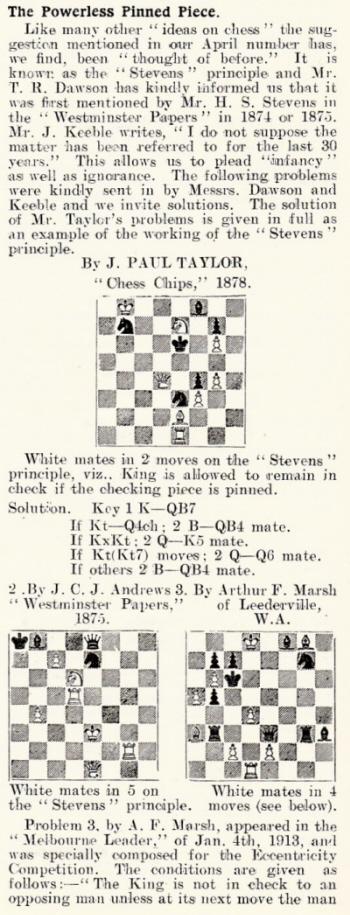
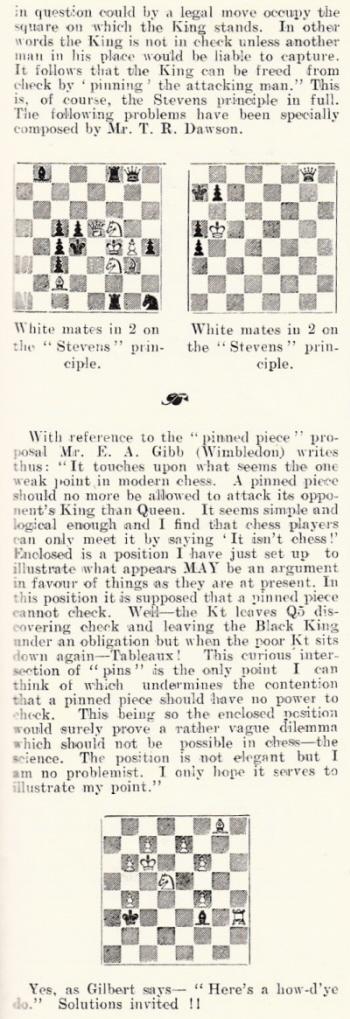
Can a brief biographical note on Samuel John Stevens be drawn up? Page 337 of the September 1928 BCM reported that he had ‘died recently in his 80th year’.
(8863)
William D. Rubinstein (Melbourne, Australia) writes:
‘Samuel John Stevens of 72 Osbaldeston Road, Stoke Newington, Middlesex died on 7 July 1928, leaving £6,197. His executor was his widow, Mary Jane Stevens. His birth was registered in the St Luke district of the City of London in the October-December quarter of 1847. In the 1901 Census he was described as a “retired engraver”, and the 1911 Census stated “Private Means”. The source of this information is the website ancestry.co.uk.’
(8865)
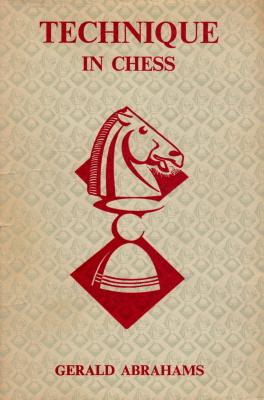
From page 215 of Technique in Chess by Gerald Abrahams (London, 1961):
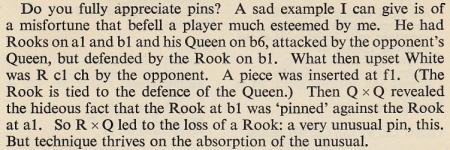
The passage was referred to in D.J. Morgan’s Quotes and Queries column on page 303 of the October 1965 BCM:

There was also a brief reference on page 359 of the December 1965 BCM.
Below is the finish as given on page 57 of the BCM, February 1948:
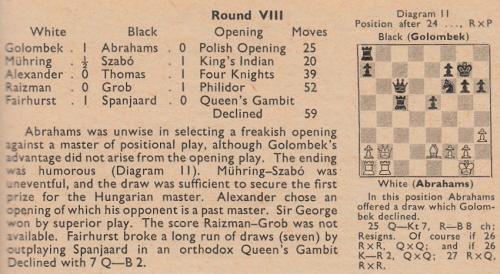
The game was ‘annotated’ by W.H. Pratten on page 121 of the February 1948 CHESS:
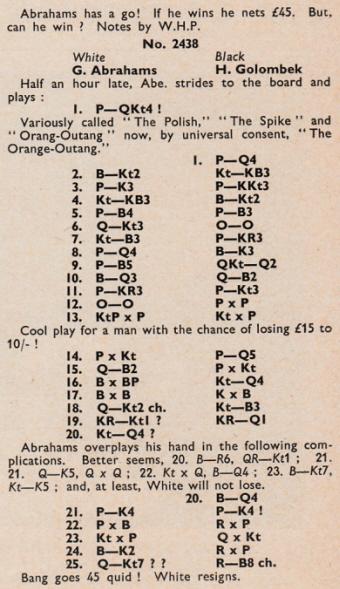
Although sometimes dated 1947, the game was played on 6 January 1948, as reported on page 7 of the Times the following day.
(8842)
As shown in C.N. 8842, this was the final position in Abrahams v Golombek, Hastings, 1948:
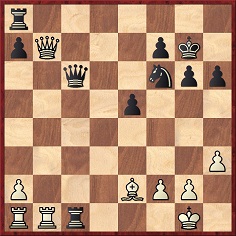
On page 67 of The Handbook of Chess (London, 1965) Abrahams gave a different position and named only Golombek:
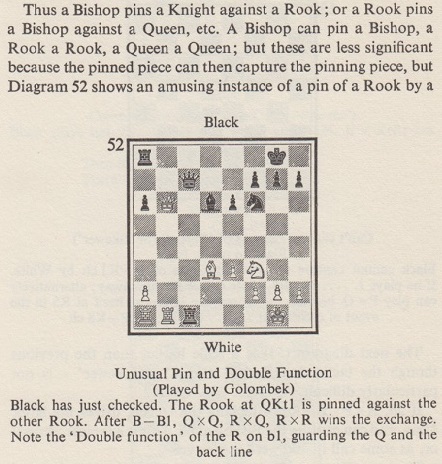
(8913)
‘Fischer, a New Tchigorin’ was the title of an article by C.J.S. Purdy on pages 134-136 of Chess World, September-October 1967. He annotated Fischer v Stein, Sousse, 1967 (the final game in Fischer’s My 60 Memorable Games) with this introduction:
‘Here is the game, which in the tournament doesn’t officially exist and yet was its masterpiece, symbolising the triumph of genius over schooled mastery.’
Purdy’s concluding observation:
‘By ordinary human standards, playing chess like White in this game would seem to require nerves of steel. Fischer’s powers of calculation and confidence in his judgment make it possible for him to conduct vital contests in a style which nobody else would venture over the board except in games played for fun. Tal certainly has played with at least equal daring, but it seems to me that he deliberately speculates. Fischer gives the impression of having everything sewn up.’
Irving Chernev tinkered with Purdy’s words on page 197 of The Golden Dozen (Oxford, 1976). The full annotations were reproduced on pages 90-92 of C.J.S. Purdy’s Fine Art of Chess Annotation and Other Thoughts by Ralph J. Tykodi (Davenport, 1992).
Purdy’s note after 25 Qg3 began:
‘The Purdy rule, “Always unpin”, is dead right here.’
(9702)
Irving Chernev on pages 167-168 of Combinations The Heart of Chess (New York, 1960):
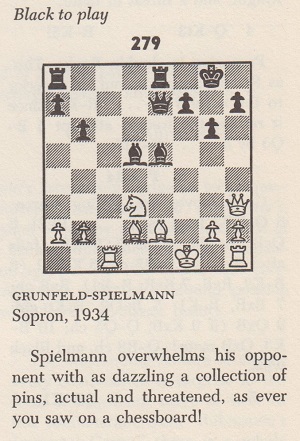
(10752)
Further information is given in the full C.N. 10752 item, as
well as C.N. 10757.
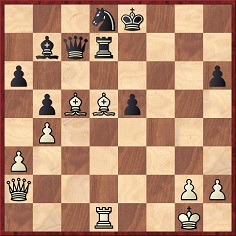
White to move
This position arose in a game won by Charles R. Gurnhill of Sheffield. It was published on page 260 of the Chess Amateur, June 1927, in the Games Department which he edited:
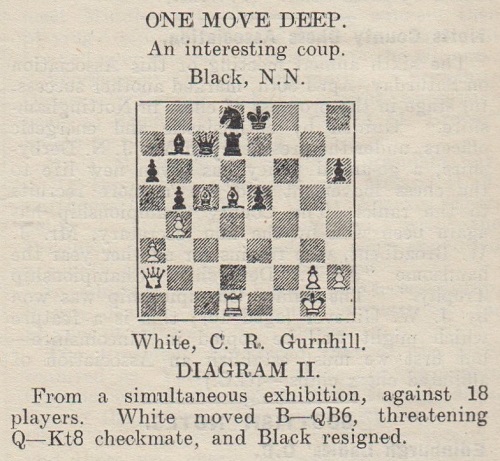
There is no record of many, or any, Chess Amateur readers being baffled by the position or asking why Black did not reply 1...Rxd1+.
From page 39 of Keene On Chess by Raymond Keene (New York, 1999):
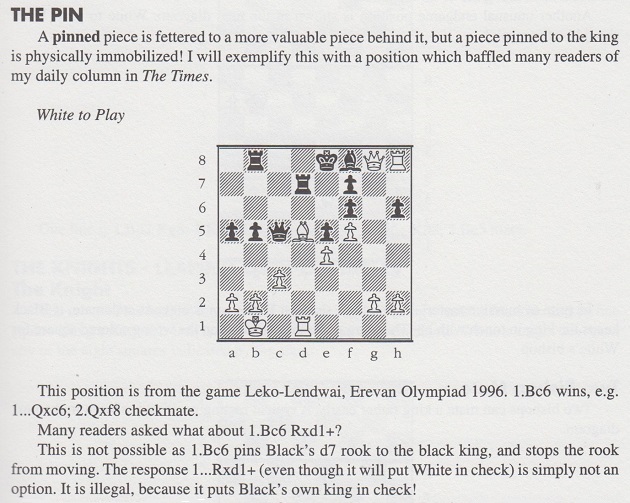
That takes up over half of one large page. The same text was repeated on page 39 of Raymond Keene’s Complete Book of Beginning Chess (New York, 2003) and on pages 40-41 of the Las Vegas, 2018 edition.
(11036)
To the Chess Notes main page.
To the Archives for other feature articles.
Copyright: Edward Winter. All rights reserved.